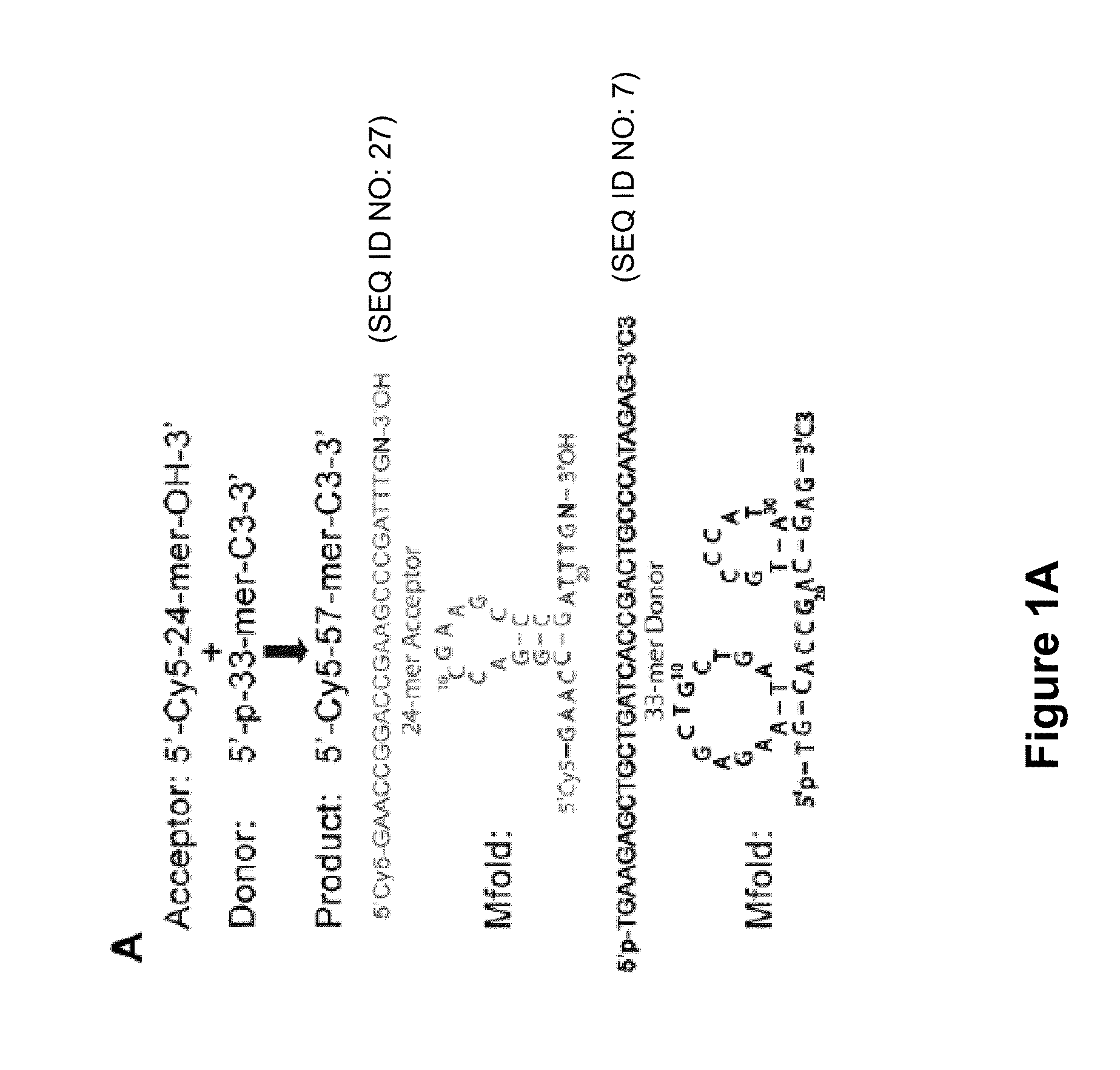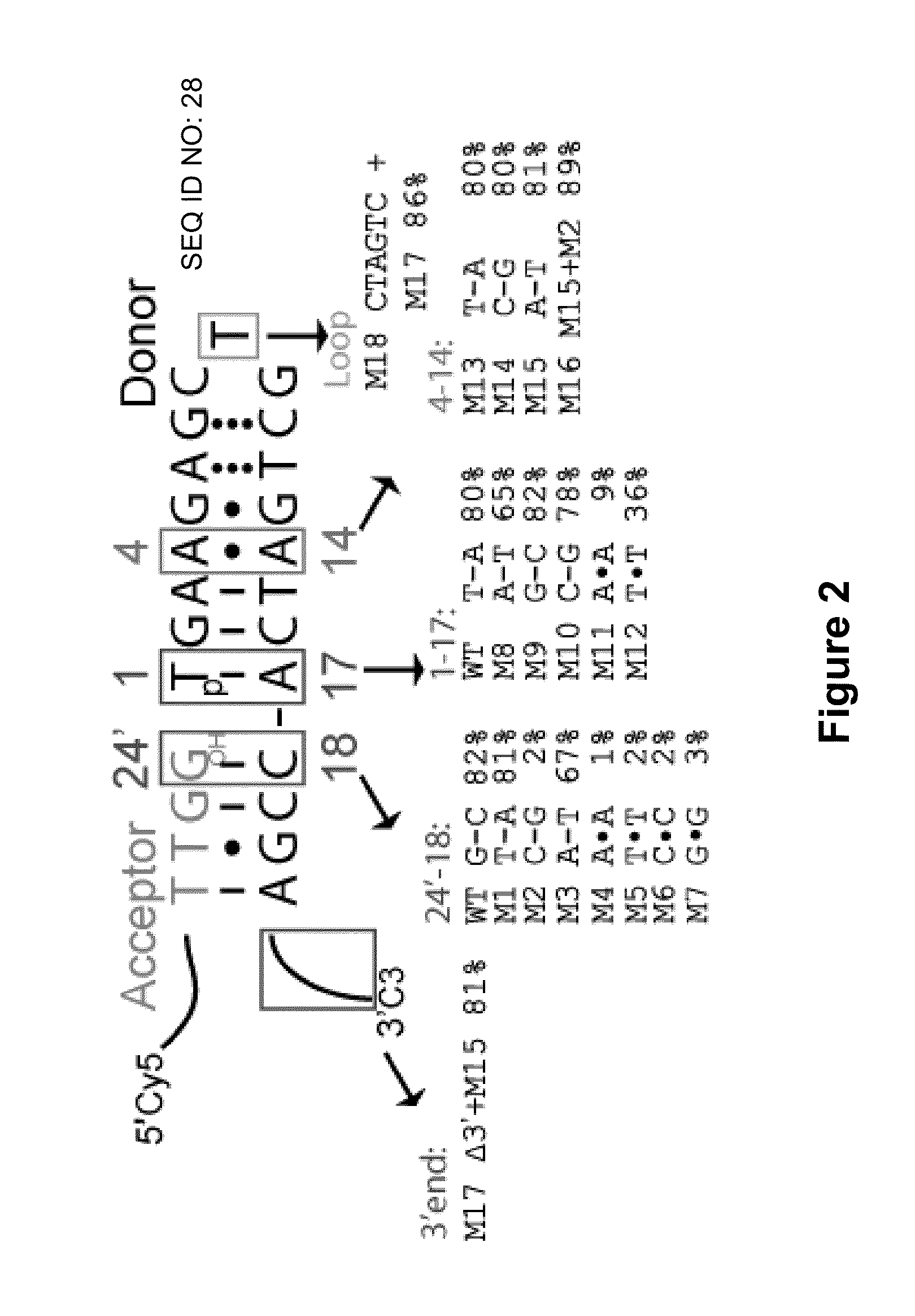Low Sequence Bias Single-Stranded DNA Ligation
a single-stranded dna and low sequence bias technology, applied in the field of low sequence bias single-stranded dna ligation, can solve the problems of inefficiency of ssdna ligation, inability to quantitatively capture the original information stored in the dna sample, and hampering the current use of ligation methods
- Summary
- Abstract
- Description
- Claims
- Application Information
AI Technical Summary
Benefits of technology
Problems solved by technology
Method used
Image
Examples
experimental examples
[0168]The invention is further described in detail by reference to the following experimental examples. These examples are provided for purposes of illustration only, and are not intended to be limiting unless so specified. Thus, the invention should in no way be construed as being limited to the following examples, but rather, should be construed to encompass any and all variations which become evident as a result of the teaching provided herein.
[0169]Without further description, it is believed that one of ordinary skill in the art can, using the preceding description and the following illustrative examples, make and utilize the compounds of the present invention and practice the claimed methods. The following working examples therefore, specifically point out the preferred embodiments of the present invention, and are not to be construed as limiting in any way the remainder of the disclosure.
example 1
A Hybridization-Based Approach for Quantitative and Low-Bias Single-Stranded DNA Ligation
[0170]Single-stranded (ss) DNA ligation is a crucial step in many biochemical assays. Efficient ways of carrying out this reaction are lacking, however. As demonstrated herein, existing ssDNA ligation methods suffer from slow kinetics, poor yield, and severe nucleotide preference. To resolve these issues, a hybridization-based strategy is presented herein, which provides efficient and low-bias ligation of ssDNA. The ligation approach presented herein is based on hybridization of an incoming acceptor DNA oligonucleotide to a hairpin DNA using T4 DNA ligase, which is fast, efficient, low-bias, and integrates seamlessly with downstream protocols. This technique can be applied in protocols that require ligation of ssDNA, including Ligation-Mediated PCR (LMPCR), and cDNA library construction. The technique could also be used in a variety of high-throughput, next generation sequencing technologies inc...
example 2
Determination of In Vivo RNA Structure in Low-Abundance Transcripts
[0201]RNA is of central importance in gene regulation, catalysis and the origin of life (Gesteland, R. F., et al., Cold Spring Harbor Laboratory Press, 2006.). Numerous classes of RNA perform key biological functions via folding into diverse structures. Knowledge of RNA structure in vivo therefore provides important insights regarding the evolution and function of biological systems. However, the structures of all but the few most abundant RNAs have been unknown in vivo.
[0202]For decades, chemical and enzymatic probing have been among the most common and powerful assays available to obtain structural information on RNA at nucleotide resolution (Ehresmann, C. et al., Nucleic Acids Res. 15:9109-9128, 1987; Stern, S., et al., Science 244:783-790, 1989; Weeks, K. M., Curr. Opin. Struct. Biol. 20:295-304, 2010 and Ding, F., et al., Nat. Meth. 9:603-608, 2012). This information can dramatically improve secondary structure ...
PUM
| Property | Measurement | Unit |
|---|---|---|
| temperature | aaaaa | aaaaa |
| pH | aaaaa | aaaaa |
| temperature | aaaaa | aaaaa |
Abstract
Description
Claims
Application Information
 Login to View More
Login to View More - R&D
- Intellectual Property
- Life Sciences
- Materials
- Tech Scout
- Unparalleled Data Quality
- Higher Quality Content
- 60% Fewer Hallucinations
Browse by: Latest US Patents, China's latest patents, Technical Efficacy Thesaurus, Application Domain, Technology Topic, Popular Technical Reports.
© 2025 PatSnap. All rights reserved.Legal|Privacy policy|Modern Slavery Act Transparency Statement|Sitemap|About US| Contact US: help@patsnap.com



